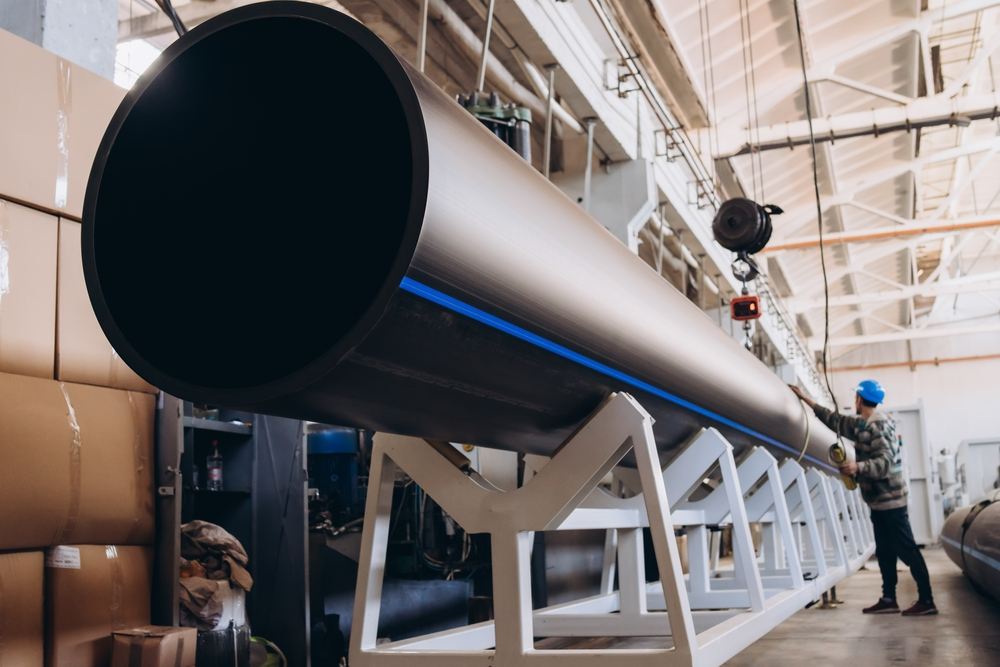When it comes to plumbing and piping projects, the two most common materials you will encounter are PVC (PVC stands for polyvinyl chloride) and HDPE (HDPE stands for high-density polyethylene). Both offer distinct advantages and disadvantages, making the choice crucial for the success and longevity of your project. In this blog, we will dive deep into the key differences between PVC and HDPE pipe, helping you select the right material for your specific needs.
What is PVC Pipe?
PVC pipes are a popular and cost-effective choice for various applications. They are known for their:
- Affordability: PVC is generally less expensive than HDPE, making it a budget-friendly option for non-critical projects.
- Rigidity: Moreover, PVC offers good structural strength and can handle moderate pressure applications like cold water lines, drainage systems, and electrical conduit.
- Chemical Resistance: Furthermore, PVC exhibits strong resistance to many common chemicals found in household and commercial settings.
- Ease of Installation: Joining PVC pipes is relatively simple, often using solvent cement or threaded connections.
However, PVC pipes also have limitations to consider:
- Limited Temperature Tolerance: PVC performs best in controlled temperatures, typically between 0°C and 45°C. Extreme cold can make them brittle and prone to cracking.
- Lower Pressure Rating: While sufficient for many applications, PVC pipes generally have a lower pressure rating compared to HDPE.
- Susceptibility to UV Degradation: PVC can degrade when exposed to direct sunlight for extended periods.
- Brittle and Less Flexible: Bending PVC pipes can increase the risk of cracks.
Additionally, we suggest reading out “Pipeline Management Trends: Innovation for a Sustainable Future.”
What is HDPE Pipe?
HDPE pipes are quickly becoming the preferred choice for demanding projects due to their superior properties:
- Exceptional Strength and Durability: HDPE boasts impressive impact resistance and can withstand high pressure, making them ideal for critical applications like water mains, gas distribution, and sewage systems.
- Superior Flexibility: Further, HDPE pipes are significantly more flexible than PVC, allowing them to navigate around obstacles and curves during installation. This flexibility reduces the need for additional fittings, saving time and cost.
- Broad Temperature Tolerance: Moreover, HDPE pipes excel in extreme weather conditions, performing well in temperatures ranging from -40°C to +110°C.
- Excellent Chemical Resistance: HDPE offers superior chemical resistance to a wider range of chemicals, including acids, alkalis, and solvents.
- UV Resistant: HDPE is not susceptible to UV degradation and can withstand prolonged exposure to sunlight.
While HDPE offers numerous advantages, it’s important to consider these points:
- Cost: HDPE pipes are generally more expensive than PVC upfront. However, their extended lifespan and lower maintenance requirements can make them cost-effective in the long run.
- Joining Methods: HDPE pipes typically require heat fusion for joining, which can necessitate specialized equipment and trained personnel.
How is HDPE Pipe Most Commonly Joined?
Traditional joining methods for HDPE pipes involve heat fusion techniques like butt fusion or socket fusion. These methods require skilled operators and specialized equipment, potentially increasing project costs. Here at LPS, we’re revolutionizing the way internally lined pipelines are built with our innovative welded joint system.
Moreover, check out “How to enhance Pipeline Integrity with FlexSleeve Technology – Case Study.”
Choosing the Right Pipe: PVC vs. HDPE
The ideal pipe material depends on your specific project requirements. Here’s a quick guide to help you decide:
- For cost-conscious projects with moderate pressure and temperature demands, PVC pipes can be a suitable option.
- If your project requires exceptional strength, flexibility, durability, and resistance to extreme temperatures and chemicals, HDPE pipes are the clear winner.
- For internally lined HDPE pipelines, consider the LPS welded joint system for its ease of installation, long-lasting protection, and cost-effectiveness.
Lined Pipe Systems
Lined Pipe Systems (LPS) is a global leader in innovative solutions for protecting the internal welds of pipelines. Founded in 2017, LPS tackled a major challenge in pipeline infrastructure: corrosion protection for weld joints when extremely high temperatures are present.
Our Mission
At LPS, we understand the critical role pipelines play in global infrastructure. Our focus is on developing contractor-friendly products that address two key needs:
- Long-lasting Corrosion Protection: Our solutions permanently safeguard weld joints from corrosion, ensuring pipeline integrity for decades.
- Fast, Efficient Construction: LPS products are designed to integrate seamlessly with existing construction techniques, minimizing project timelines and costs.
Years of Research, Proven Results
Through extensive research and testing, LPS has developed the most cost-effective and user-friendly solutions for constructing pipelines with internal coatings and linings.
LPS: Serving the World from Southern California and Brazil
LPS is headquartered in Southern California, USA, with a global reach. Our research and development, along with manufacturing facilities, are located in Minas Gerais, Brazil. This strategic positioning allows us to serve clients worldwide with exceptional products and support.
LPS Technologies
LPS offers a variety of innovative technologies to meet the specific needs of your pipeline project. These include:
- FlexSleeve® for Thin Linings: Ideal for protecting thin internal linings in high-temperature applications.
- CCB® Sleeve for Thin Linings: Provides a cost-effective solution for weld joint protection with thin liners.
- SealSleeve™ for Rubber & PU Linings: Designed for superior corrosion resistance with rubber and polyurethane linings.
- SealSleeve™ for Thermoplastic Liners: The perfect choice for safeguarding pipelines with thermoplastic internal liners.
Contact LPS Today
Lined Pipe Systems is committed to providing the most advanced and reliable solutions for protecting your pipeline investment. Contact us today to discuss your project requirements and discover how LPS technology can ensure the longevity and performance of your pipelines. You can also follow us on YouTube for more informational and practical details on our technologies.
Conclusion
By understanding the strengths and limitations of PVC and HDPE pipe, you can make an informed decision for your next plumbing or piping project. Therefore, for projects demanding superior performance and long-term value, HDPE pipes often emerge as the preferred choice.





